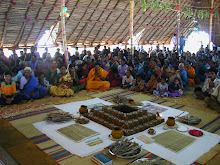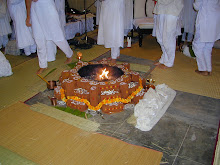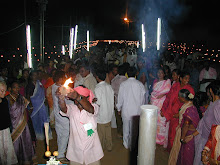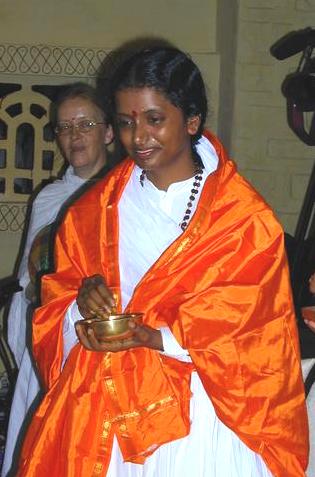A Sadhana is a spiritual practice such as yoga and meditation. There is a sacred trinity in ancient enlightenment cultures made up of Sadhanas (spiritual practices), Maha Sutras, and Diksha (spiritual initiations-aka deeksha-for more info visit www.dikshas.com ).
Some have come to me week after week for deeksha. Initially this was very puzzling as I found myself wondering what was wrong with the last deeksha, that some were back so soon. Others would announce that it was their 6th deeksha circle that week-that they go from place to place getting as many deekshas as they could. This was all very new to me.
The early teachers, including Arthri, Ranji, Uttama. Leilaji, Raviji, Mohanaji and I conducted retreats and workshops for years, sometimes for very large groups of people after receiving just several deekshas-2-4 a year. Many of the attendees grew in amazing ways. We relied very heavily on Grace, sadhanas and contemplation of sutras to enhance our states and our abilities to help others.
Deeksha was a small yet integral part of the early processes. Maybe 8-12 hours total out of 42 days were spent while the deeksha was given to the whole group. This transmission of spiritual energy (deeksha) was done as a very a sacred ritual where at the very least we showered first, definitely washed our hair, and put on clean clothing. Many prayed and fasted in preparation and remained in silence (another type of sadhana) before, during and after. The Dhyana Vihar (meditation center) was softly lit with candles and beautiful incense. A life-sized Sri Murthi surrounded by fruits and flowers was at the front and Acharya Ananda Giriji and the male monks sat to the right of the Sri Murthi. Ananyaji was to the left.
The monks chanted as we knelt in perfect silence as a group. No one moved, opened their eyes, left the Dhyana Vihar or spoke (with the exception of receiving Deeksha for the State of the Laughing Buddha where is was almost impossible not to laugh) until the entire group had received deeksha. There was a tangible shift when all had received deeksha- a sense of inter-connectedness-of being one great creature with many arms. Anything was possible, it seemed. There was a perception that each individual mind was part of a collective mind-no separation really and in this realization it was seen that each had the power to help any one or all. It became more of a group journey than an individual journey from then on to me.
If you think of the deeksha as a seed of enlightenment, the sadhanas as the rain, and the sutras as the sun and if you are missing the contemplation of the sutras (the sun), the sadhanas (the rain) how is the seed (deeksha) going to grow? It is like you were given a paper cup with a seed in it and you stuck it in on a shelf. You killed your little seedling before it had even a chance to transform and flower (relating to flowering of the heart), then complained to the seed manufacturer that the seed was a dud and went out trying brand after brand after brand of seed to no avail. Still no flowering. Those that work with and nurture the seed they have been given-even if it is one only, often grow in remarkable ways.
Keep in mind just as when a plant grows it moves the earth (in this example the recipient of the deeksha can be likened to the soil), it is my experience that the changes can be quite unsettling if you are not practicing some form of sadhana and contemplating sutras. Both are wonderful preparations and a large degree transformation can occur.
As in the words of a local shaman called Coyote, "If you give enlightenment to a goat, it will still be a goat." Some degree of transformation can be very beneficial before mukti (enlightenment or liberation) such as God Realization, Discovery of the Love, setting right relationships. Not all enlightened beings throughout history were God Realized or had good relationships.
If you try just practicing some sadhanas and contemplate a sutras measure your growth. As sadhanas are employed the body and its powers change. There is an explanation of a sutra "Suffering is a Constant" in an early workshop format at www.vedicshamanism.com/index10.html. The yin and yang symbol is an icon of a sutra. Can you see it?
New sadhanas are currently being given by the Oneness Movement. So you can see the evolution, following were the required prerequisite sadhanas for the participants before going to the first retreats at Satyaloka. More sadhanas were given at the yajnas that were also required. It will give you an idea of how the early teachers lived for many years.
When we did the sadhanas the intent was not only for personal growth but it was something we did for the enlightenment of man. Many were given visions of the Golden Age early on and we were shown what it would be if man made it and what it would be if man did not make it. There was a passion for a shift enmass and it seemed such a little thing to do. It was that and only that that made it possible to keep this type of lifestyle.
If sadhanas are something you decide do for yourself alone, soon many would stop. So if you decide to start practicing sadhanas, know in your heart that the microcosm impacts the macrocosm. Just as if you put a drop of yogurt in a glass of milk soon all of the milk is transformed. What you are doing-this sacrifice of time and energy to enhance your own state, you are ultimately doing for mankind.
These were the early preparatory sadhanas. Titled "Preparation for the Sadhakas (Spiritual Aspirants) Traveling to Satyaloka" For most they started in January for a June-Aug Yajna (Retreat)-a 6 week minimum preparation practice:
No smoking
Strict vegetarian diet
No caffeinated drinks
Strict celibacy
Fruit Diet once a week-same day every week. (This cleanses mucus from the colon.)
Early morning meditation 5:30 AM-7:00AM or earlier for 1.5 hours
1 Take shower (cold)
2. Meditation should be done on an empty stomach
3. Chant the Moola Mantra 7 times
4. Pranayama 1, 2 and 3 15 minutes
5 Prana Kriya 1,2 and 3 9 minutes
6. Breath Awareness 5 Minutes
7. Deep Inhalation and Exhalation 5 minutes
8. Brumadhya Dhyana 10 minutes (the area between the eyebrows-the screen that you dream on)
9 Go into Savasan and meditation continues:
-Brumadhya Dhyana 5 minutes -move awareness from Bruhmadhya to Sahasrara (crown of the head)
-Sahasrara Dhyana 5 Minutes-Move Awareess from Sahasrara to Brumadhya
-Brumadhya Dhyana-5 Minutes-move awareness from Bruhmadhya to Anahata (Spiritual Heart)
-Anahata Dhyana 5 minutes
Meditation ends
10 Relax in Savasan 20 minutes
11 Chant the Moola Mantra 3 times
Evening Meditation 8:30-10:00 PM (or any other time but it must be the same time every day.
Same format as morning meditation...........
Wednesday, October 22, 2008
Subscribe to:
Post Comments (Atom)































No comments:
Post a Comment